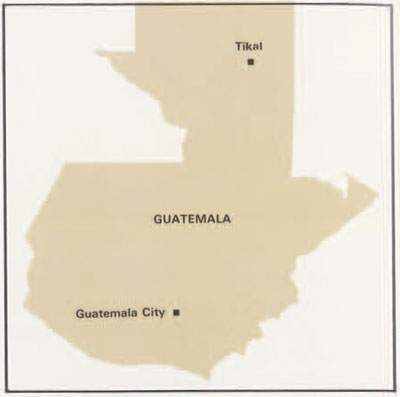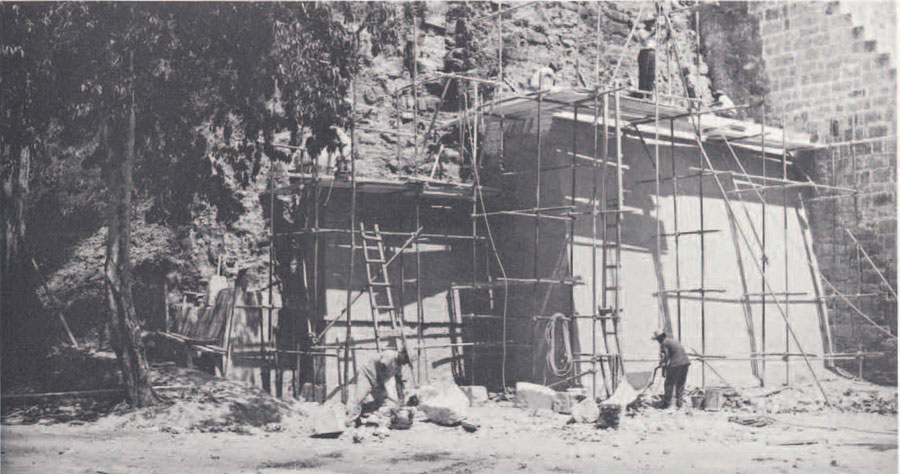- Work in progress on great Temple II. The man at the left is trimming a stone with a hatchet.
- Recently completed large palace on the Central Acropolis, with Great Temple II and the South Acropolis in the background.
- Cutting stone by handsaw in the quarry.
- Masons repairing a wall on the North Acropolis.
- A small Early Classic structure on the Central Acropolis in the architectural style of Teotihuacan in central Mexico.
In 1956, when the Museum undertook the tremendous task of making a thorough archaeological study of the ruins of Tikal, we had no idea of the extent of the work that would have to be done to provide a reasonable adequate picture of the site’s history, social organization, economy, and final abandonment.
The first major job that had to be done was the establishment of a camp to house the archaeological staff and the work force, as well as the providing of a water supply. The latter posed many problems, but was eventually accomplished by clearing out one of the reservoirs built by the Maya. I don’t believe that anyone at that time foresaw the need for as much water as has been required in the last five or six years as a result of the growth of tourist accommodations at the Jungle Inn, and by the conservation program that was started in a modest way in 1959 and has since been so greatly expanded that at this writing it has become, with the exception of some small terminal archaeological operations, the only activity for which the Museum is responsible at Tikal.

In the history of modern Mexican and Central American archaeology, there have been two major goals—excavation for the recovery of evidence upon which to draw historical and cultural conclusions, and the repair and preservation of monuments of interest to the public and of such aesthetic or historical importance that it would be unthinkable that they should be destroyed.
A perfect example of complete emphasis on the first goal, excavation to obtain knowledge, is in the work of the Carnegie Institution of Washington in the 1920’s and ’30’s at Uaxactun (Wash-ak-toon), about fifteen miles north of Tikal. Accessible then only by river boat and mules, the site was nowhere nearly so spectacular nor architecturally so well preserved before excavation as was Tikal. The Carnegie archaeologists therefore made complete excavations in a number of groups of buildings, razing them to the ground in order to work out their rather complex histories of covering older structures with new ones, often many times, as well as of lesser rebuilding operations. In short, no effort or money was expended on creating a tourist attraction. This procedure has never been seriously criticized, and the amount of information recovered was for many years the most complete from any site in the jungle of northeastern Guatemala.
In contrast to the work at Uaxactun, the Carnegie Institution excavated at a number of Maya ruins that were both much more easily accessible and in far better state of preservation. At such famous sites as Copan, in western Honduras, and Chichen Itza, in northern Yucatan, excavation and preservation were very skillfully combined to extract information and leave beautiful and instructive exhibits for the delectation of thousands of visitors. The Mexican Government, above all others in Latin America, have practiced this procedure at many sites—Teotihuacan, Monte Alban, Cholula, El Tajin, to name only a few.
At Tikal it was evident from the beginning that we would have to plan excavations in such ways as to do as little damage as possible to major buildings, especially those with standing vaulted rooms. Even had the Guatemala Government not proclaimed Tikal and a large area around it a National Park and had they not obviously been interested in attracting tourists, we would have been morally obligated not to totally destroy any structures of monumental value. We therefore made trial excavations in minor buildings well away from the ceremonial center of the site, to become familiar with constructions, and we later dug a large number of domestic structures that were necessary to obtain a good sample of all types of Tikal architecture. These small, low houses were too badly destroyed by tree roots to repair.
The real problem, then, was in the tracing of ceremonial architecture throughout its fifteen hundred year history. The difficulty lay in the fact that almost all of the major buildings to be seen above ground were of Late Classic construction (A.D. 600-900). Many of these large temples, especially those on the North Acropolis, cover earlier temples, with a succession of buildings, tombs, and floor levels going back to about 600 B.C. at bedrock in a gigantic trench dug by William Coe. This trench was planned to be refilled and only half of one small temple had to be removed to provide space for it. The trench is now refilled and the small temple has been rebuilt. It was frustrating not to be able to dig thoroughly a much larger section of the North Acropolis, but by the judicious use of lateral tunnels Dr. Coe was able to draw a cross section graphically illustrating the history of the Acropolis, and, by correlating floor levels, he was able to tie in the palaces of the Central Acropolis across the Great Plaza, as well as Great Temples I and II facing each other at the east and west ends of the Plaza.
Many of the latest temples on the North Acropolis, covering earlier ones built in Early Classic (A.D. 300-600) times, were so badly damaged that it was impossible to consolidate and repair them as useful exhibits.In several such cases the outer rubble of the latest construction was removed, thus exposing quite well preserved Early Classic buildings. By consolidating and leaving in place sections of the debris of the latest construction, it is possible to give the visitor an excellent physical example of the succession of buildings, as explained in Dr. Coe’s Tikal: A Handbook of the Ancient Maya Ruins. This type of preservation requires relatively little rebuilding. The Great Temples, however, and the large palaces of the South Acropolis pose much more difficult problems. A great deal of consolidation of the old masonry must be done, which almost always necessitates the re-cutting of stone; the work requires good teams of masons and their assistants.
During the early years of this sort of work on Temple I, under the direction of the late Aubrey Trik, there was plenty of stone that had fallen from the facades of numerous buildings. Lately, under the current direction of George Guillemin, we have had to re-open the old Maya quarries for the needed stone. We also have had, until lately, to burn limestone for slaking to be mixed as cement with crushed stone. Even on a small scale these operations require considerable manpower, which makes one appreciate the vastly greater amount of labor that the Indians had to expend to build the hundreds of temples and palaces to be seen at Tikal.
Most people visiting Tikal today would probably wonder why our quarrying and stone trimming operations are so primitive—the men use large saws, hatchets, and machetes. The answer is that elsewhere today such work is done almost entirely with power tools that require lubrication of the stone by a great deal or water, which is simply not available; and the mixing of cement also uses up a great deal of water.

There still remains another difficult problem—the preservation of sculpture in lime stucco, which was used very extensively in the decoration of building facades. We are now experimenting with newly developed materials in the hope that at least some of the huge stucco masks may be protected from the ravages of exposure to the hot, moist climate. The guiding principle of conservation of this kind, especially when wall heights cannot be established or where sculptural detail is not clear, is not to over-reconstruct. Unless we are sure that there is good physical evidence for reconstruction we limit ourselves to consolidation and repair only. Reconstruction should also be distinguishable from original or repaired masonry. This is why, if you visit Tikal, you will not find a single vaulted room in Temple II, for example, which required extensive repairs, some to the extent of rebuilding which could not have been done without the original to copy exactly. Nor will you find any stucco work that has been “touched up.”
The reader may now be wondering how the Museum could afford to carry on a conservation program on top of a long and expensive series of excavations. We did pay for the work on Temple I and some other minor work, but since late 1964 the program has been financed by the Guatemalan Government. Such an arrangement between a Latin American government and a North American university for the conduct of a program of archaeological conservation is unprecedented. The Government has also, from the inception of the CProject in 1956, furnished all the air transport of supplies and personnel. Without this support neither the archaeological work nor the conservation program could have been properly undertaken, and the development of one of the most fascinating National Parks anywhere in the world would probably never have been started. By the end of 1969, when our contract with the Government expires, we hope to have achieved an interesting and attractive balance between magnificent architecture and sculpture, that could not be appreciated when buried in the high jungle, and the equally interesting jungle itself, which still covers a very large proportion of the site.





